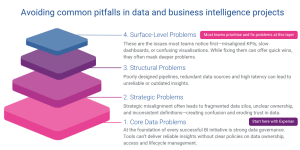A common mistake? Teams often rush to fix surface-level issues—such as slow dashboards or mismatched KPIs—because they’re the most visible and annoying. However, these are often just symptoms of deeper issues. To build truly effective BI systems, organisations must start at the core and work their way up.
We’ll explore each category, identify the warning signs and offer practical tips to overcome them.

1. Core Data Problems: Governance
The Pitfall: At the foundation of every successful BI initiative is strong data governance. Without clear policies around data ownership, access, and lifecycle management, even the best tools can’t deliver reliable insights.
Common Signs:
- Inconsistent data access policies.
- Lack of data stewardship roles.
- Unclear data lineage.
Tips to Overcome:
- Establish a data governance framework with defined roles and responsibilities.
- Implement data cataloguing and lineage tracking tools.
- Regularly audit data access and usage to ensure compliance and security.
Why it matters: Fixing governance issues may not offer immediate visual wins, but it builds the confidence and consistency that every other layer depends on. Experian’s Data Catalogue and Governance solution helps organisations build a trusted data foundation. It enables clear ownership, policy enforcement, and visibility across the data lifecycle—ensuring that governance is not just a policy, but a practice. With better control and transparency, teams can trust the data they use to make decisions.
2. Strategic Problems: Silos, Ownership, Quality and Definitions
The Pitfall: Strategic misalignment often leads to fragmented data silos, unclear ownership and inconsistent definitions—creating confusion and eroding trust in data.
Common Signs:
- Different departments using different definitions for the same or similar metric for example ARPC, Average revenue per customer; ARPU, Average revenue per user; ARPPU, Average revenue per paying user and RPS, Revenue per subscriber.
- Data quality issues going unresolved.
- No single source of truth.
Tips to Overcome:
- Create a centralised data strategy aligned with business goals.
- Assign data owners for key domains and empower them to maintain quality.
- Develop and maintain a business glossary to standardise definitions.
Why it matters: Without strategic alignment, teams may build various dashboards that tell conflicting stories. Experian’s Data Catalogue and Governance solution plays a critical role here. It helps break down silos by aligning data ownership and stewardship across departments. By enforcing consistent definitions and quality standards, it ensures that everyone in the organisation is speaking the same data language—reducing friction and improving collaboration.
3. Structural Problems: Duplications, Integrations, Pipelines and Latency
The Pitfall: Even with good governance and strategy, technical issues in data architecture can cripple BI efforts. Poorly designed pipelines, redundant data sources and high latency can lead to unreliable or outdated insights.
Common Signs:
- Multiple versions of the same dataset.
- Frequent ETL failures or delays.
- Inconsistent schema across systems.
Tips to Overcome:
- Consolidate data sources and eliminate redundancies.
- Invest in robust ETL/ELT tools with monitoring and alerting capabilities.
- Design for scalability and low-latency access, especially for real-time analytics.
Why it matters: A strong structure ensures that data flows smoothly and accurately to the tools and people who need it. Experian’s Single Customer View (SCV) solution is purpose-built to tackle structural data challenges. By consolidating fragmented customer records across systems into a unified, accurate view, it eliminates duplication and inconsistency—two of the biggest culprits in structural inefficiencies. This not only improves data quality but also streamlines integration and reporting, enabling faster, more reliable insights across your BI ecosystem.
4. Surface-Level Problems: KPIs, Queries and Dashboards
The Pitfall: These are the issues most teams notice first—misaligned KPIs, slow dashboards, or confusing visualisations. While fixing them can offer quick wins, they often mask deeper problems.
Common Signs:
- Reports take too long to load.
- KPIs don’t reflect actual business performance.
- Users avoid dashboards due to complexity or inaccuracy.
Tips to Overcome:
- Collaborate with stakeholders to define meaningful, actionable KPIs.
- Optimise queries and leverage caching or materialised views.
- Design dashboards with user experience in mind—clarity, speed and relevance are key.
Why it matters: Surface-level fixes are important, but without addressing the underlying data issues, they’re just a temporary patch.
Final Thoughts
It’s tempting to start fixing what’s most visible. But in data and BI projects, true success comes from building a strong foundation—starting with governance, aligning strategy, reinforcing structure, and then refining the surface.
Start at the core. Build upward. Deliver lasting impact.
Contact us to learn more
